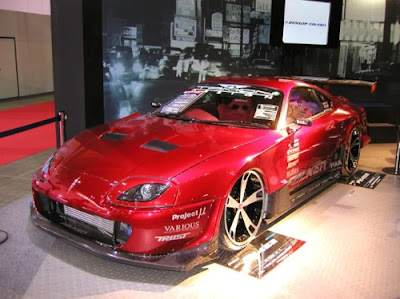 General Motors is moving ahead with the development of the Chevrolet Volt that’s scheduled to enter production in 2010 (see here). In order to maximize the electric range, GM is focusing on improving the aerodynamics of the vehicle. The image above that was released by GM illustrates one of the latest design themes undergoing a wind tunnel test at the American carmaker’s Aero Lab in
General Motors is moving ahead with the development of the Chevrolet Volt that’s scheduled to enter production in 2010 (see here). In order to maximize the electric range, GM is focusing on improving the aerodynamics of the vehicle. The image above that was released by GM illustrates one of the latest design themes undergoing a wind tunnel test at the American carmaker’s Aero Lab in Press Release
Chevrolet Volt Development Moves Forward With Focus On Aerodynamics
Warren, MI –The massive fan in GM’s aero lab wind tunnel has been cranked up to full blast as GM’s designers and engineers work to optimize the aerodynamics of the Chevrolet Volt as part of the quest to make the breakthrough concept car a production reality. Aerodynamic improvement is a critical step in meeting the range targets necessary for moving the vehicle to a final production decision.
The design team, now with its own studio dedicated to the development of vehicles powered by the E-flex propulsion system, has been working with engineering, aerodynamicists and other scientists to develop an energy efficient Chevrolet Volt by optimizing aerodynamics.
“One of the ways design can contribute to the efficiency of any vehicle is through the aerodynamics of the body shape,” says Ed Welburn, VP, GM Global Design. “The collaboration between a designer and an aerodynamicist can not only contribute to improved fuel economy or extended range, but can produce beautiful and different body shapes.”
Frank Weber, Global Vehicle Line Executive and Global Vehicle Chief Engineer for the E-Flex System, agrees. “The electric range of the Chevrolet Volt is most sensitive to improvements in aero, which is in contrast to a traditional vehicle program in which mass typically plays a larger role.”
Reducing drag
Aerodynamic drag accounts for approximately 20 percent of the energy consumed in an average vehicle, directly impacting vehicle fuel efficiency. GM designers apply their expertise to address the opportunity to improve the fuel economy of all GM vehicles. In fact, GM offers more fuel efficient vehicles than any other manufacturer, in part due to vehicle design and GM’s aerodynamic development capabilities.
GM’s aerodynamics laboratory, located at the technical center in
Aerodynamics development begins with a 1/3-scale model where basic shape and major features are defined. The model includes a highly detailed underbody and engine compartment. Radiator and under hood cooling flow is developed with computational fluid dynamic models. Simultaneously, computation development takes place to determine aerodynamic drag of design alternatives. Development continues with full-scale models, where shape is refined and optimized for low wind noise. The development process concludes with a vehicle prototype validation of the math-based analysis and physical testing.
“I'm proud to say that after extensive aero development of the Volt, and more to come, we have achieved a vehicle that had a coefficient of drag that is more 30% lower in drag than the original concept,” said Welburn. “It’s not easy, but it is a necessity.”


















